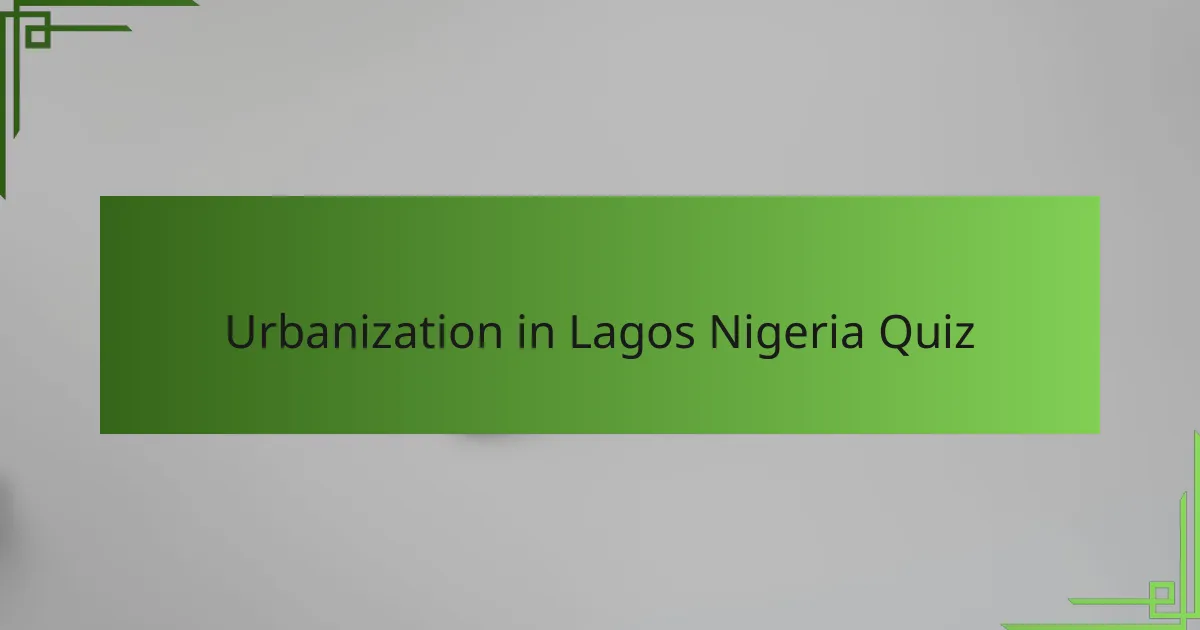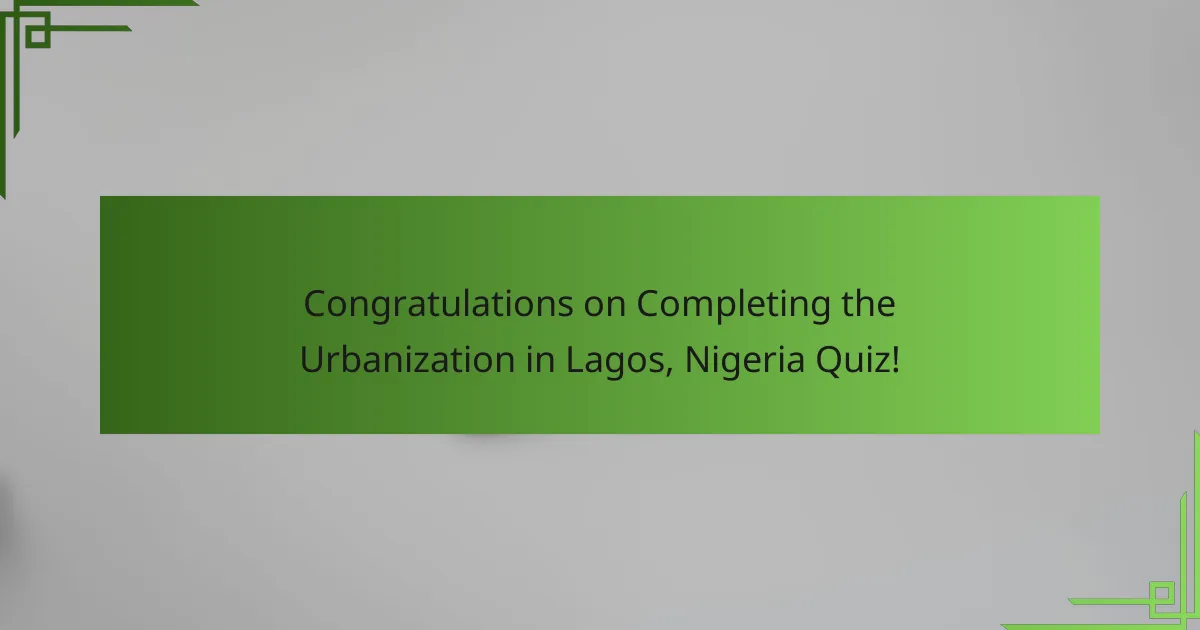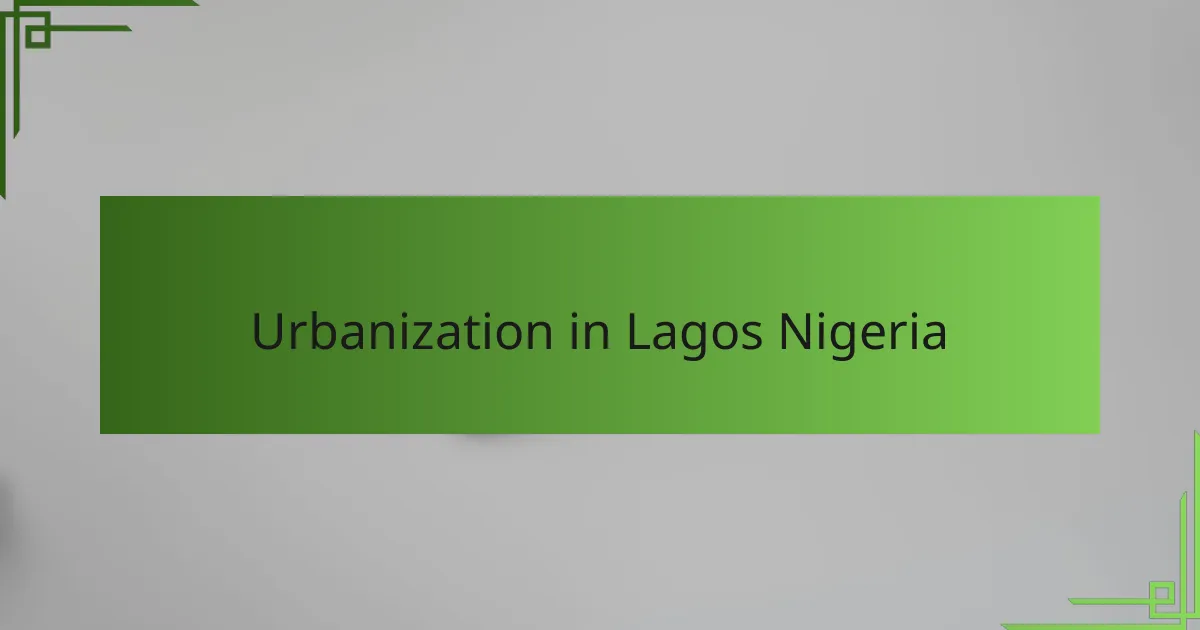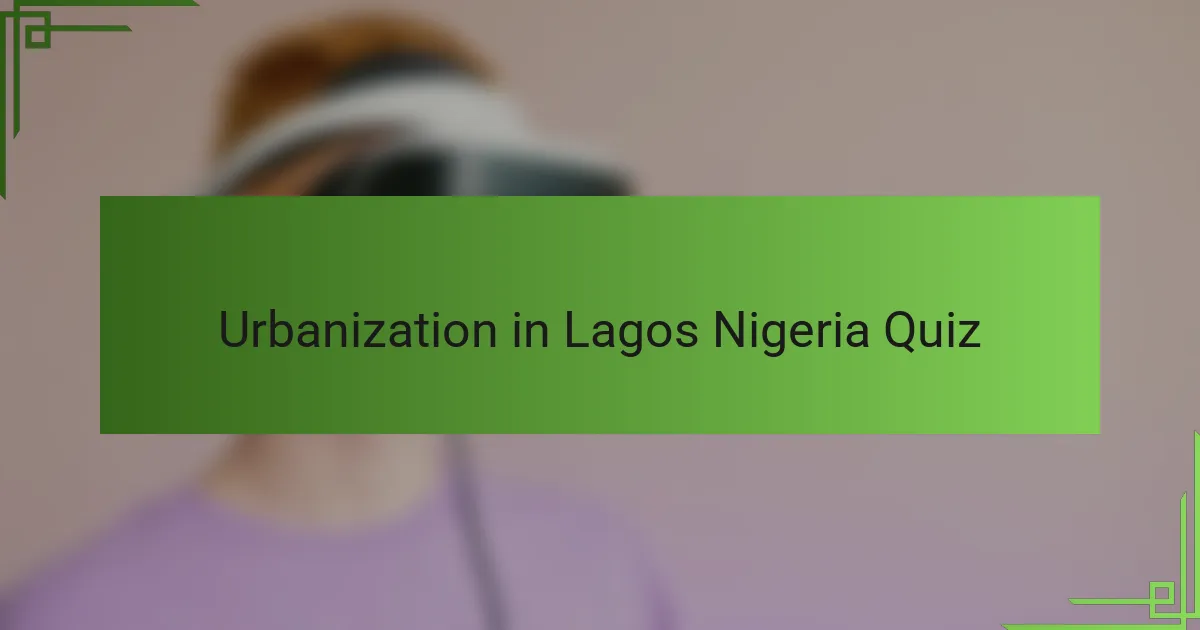
Urbanization in Lagos Nigeria Quiz
1. What is the primary geographical location of Lagos within Nigeria?
- Northwestern Nigeria adjacent to the border with Benin
- Northeastern Nigeria near the borders with Niger and Chad
- Southwestern Nigeria along the Atlantic coast
- Central Nigeria within the Jos Plateau region
2. Which body of water borders Lagos to the south, influencing its urban development?
- Gulf of Guinea
- Atlantic Ocean
- Bight of Benin
- Lagos Lagoon
3. What is the name of the lagoon around which much of Lagos`s urbanization has occurred?
- Lekki Lagoon
- Victoria Island Lagoon
- Lagos Lagoon
- Tarkwa Bay Lagoon
4. How has Lagos Island played a role in the city`s urbanization history?
- Lagos Island was primarily a residential district with limited influence on the city`s urban expansion.
- Lagos Island served as the historic commercial and administrative center that sparked urban growth in Lagos city.
- Lagos Island remained a rural enclave while the city urbanized around it.
- Lagos Island developed mainly as a transportation hub without significant commercial activity.
5. What is the significance of the Eko Bridge in connecting different urban parts of Lagos?
- It links Ikoyi directly to Victoria Island, easing traffic between residential and business districts.
- It serves as a main transit route between Lagos Airport and Lekki Peninsula.
- It connects the Epe area directly to Lagos Island, promoting regional trade movements.
- It connects Lagos Island to the mainland, facilitating key commuter and commercial traffic flows.
6. Which area in Lagos is known as a commercial hub influencing urban growth?
- Lekki
- Ikeja
- Victoria Island
- Lagos Island
7. What geographic challenge does Lagos face due to its low-lying coastal position?
- Limited freshwater resources due to upstream river diversion
- Isolation from major trade routes due to mountainous terrain
- Vulnerability to flooding due to rising sea levels and tidal surges
- Frequent droughts caused by inland desertification
8. How has the expansion of the Lagos metropolitan area affected surrounding geographic regions?
- It has resulted in the complete abandonment of rural settlements as people relocate to Lagos.
- It has caused a significant reduction in coastal fishing activities due to water pollution.
- It has led to increased urban sprawl and pressure on agricultural lands in the surrounding states.
- It has caused rising sea levels around Lagos due to excessive groundwater extraction.
9. What role does the Lekki Peninsula play in the urban geography of Lagos?
- The Lekki Peninsula serves as a major residential and commercial expansion area, alleviating population pressure from central Lagos.
- The Lekki Peninsula is primarily an industrial hub focused on heavy manufacturing and port activities.
- Lekki Peninsula is predominantly a historical district preserved for tourism and cultural heritage.
- The peninsula functions mainly as an agricultural zone, producing most of Lagos` food supply.
10. How has traffic congestion in urban Lagos been impacted by its geographic layout?
- Lagos`s flat terrain encourages high-speed traffic flow, reducing congestion despite urban density.
- The extensive waterways and fragmented landmasses of Lagos lead to reliance on bridges and ferries, which bottleneck traffic and increase congestion.
- Elevated metro lines throughout Lagos have eliminated surface traffic congestion by providing alternative transit.
- The city`s grid-like road design evenly disperses vehicles, preventing traffic build-up in most areas.
11. What geographic feature distinguishes Victoria Island as a key part of Lagos city?
- It is a volcanic island rising sharply from the surrounding sea
- It is an artificial island created through land reclamation in Lagos Lagoon
- It is a coral atoll located near Lagos’ coastal waters
- It is a natural peninsula formed by sediment deposits in the Atlantic Ocean
12. How have Lagos`s ports influenced its geographic urban expansion?
- The ports influenced urban expansion mainly through rural agricultural zones north of Lagos, rather than coastal areas.
- The ports primarily caused Lagos’s urban expansion inland, away from the coast, due to pollution and overuse of coastal land.
- Lagos`s ports have driven the city’s urban growth predominantly along the coastline, facilitating trade and attracting industries to seaside zones.
- Lagos’s urban sprawl developed mainly around its airports, with ports having minimal impact on geographic expansion.
13. What is the impact of Lagos`s tropical climate on its urban geography?
- The climate`s strong winds predominantly drive industrial development in the northern suburbs rather than the coastal city center.
- Lagos`s tropical climate promotes high population density in coastal urban areas due to year-round warmth and rainfall encouraging economic activities like fishing and trade.
- The tropical climate causes seasonal droughts that limit urban growth to inland areas, reducing coastal population density.
- Cooler temperatures associated with Lagos`s tropical climate lead to urban expansion mainly in elevated zones away from the coast.
14. Which geographic factor has contributed to Lagos`s rapid population growth in urban areas?
- Location within a major desert region
- Coastal location with access to maritime trade routes
- Proximity to extensive freshwater lakes
- High elevation providing natural defense
15. How does the layout of the Lagos Mainland compare geographically to Lagos Island in terms of urbanization?
- Lagos Mainland has a denser urban core with more commercial high-rises than the more suburban Lagos Island.
- Lagos Mainland is generally more industrial and residential with less dense urban core compared to the highly commercial and densely populated Lagos Island.
- Lagos Mainland is mostly rural with few urban developments, while Lagos Island is the only fully urbanized area.
- Lagos Mainland is predominantly coastal and tourist-focused, whereas Lagos Island is mainly industrial and residential.

Congratulations on Completing the Urbanization in Lagos, Nigeria Quiz!
Thank you for taking the time to explore the fascinating topic of urbanization in Lagos. This quiz has offered you a chance to test and expand your knowledge about how Lagos has grown and transformed over the years. You’ve gained insights into the factors driving its rapid urban development, the challenges faced by its residents, and the unique geographical features shaping this dynamic city.
Throughout the quiz, you may have learned about population growth, housing issues, infrastructure demands, and environmental impacts in Lagos. Understanding these concepts is essential in grasping the complex nature of urban geography. Recognizing the real-world implications of urbanization helps us appreciate the efforts needed to create sustainable and livable cities for the future.
We invite you to continue your learning journey by checking out the next section on this page. It offers detailed information and analyses on urbanization in Lagos, Nigeria, which will deepen your understanding of this vital geographical phenomenon. Keep exploring, and enjoy discovering how geography shapes the world around us.

Urbanization in Lagos Nigeria
Overview of Urbanization in Lagos, Nigeria
Urbanization in Lagos, Nigeria, refers to the rapid increase in population and expansion of the city’s built environment. Lagos is Nigeria’s largest city and one of the fastest-growing cities in the world. The urban growth is driven by rural-urban migration and natural population increase. This phenomenon has transformed Lagos into a megacity with over 20 million residents as of recent estimates. The geographic expansion includes spreading into swampy and coastal areas, posing significant challenges for infrastructure development and environmental management.
Geographical Factors Influencing Urban Growth in Lagos
Lagos’ urbanization is heavily influenced by its geographic location on the coast of the Gulf of Guinea. The presence of Lagos Lagoon and its connection to the Atlantic Ocean has supported trade, fishing, and transportation, attracting settlers. Additionally, the city’s flat terrain and proximity to water bodies have facilitated urban sprawl. However, these geographical factors also contribute to flooding risks, especially during rainy seasons, challenging sustainable urban development in areas like Victoria Island and Ikorodu.
Spatial Distribution and Land Use Patterns in Lagos
The spatial distribution of urban areas in Lagos shows a mix of residential, commercial, and industrial zones. Land use is highly heterogeneous, with affluent districts such as Ikoyi and Victoria Island characterized by high-density commercial buildings and upscale housing. In contrast, sprawling informal settlements like Makoko demonstrate unplanned growth. The transportation network, including roads and the Lagos Metro Rail, intersects these zones, shaping land use and fostering both vertical and horizontal urban expansion.
Impact of Urbanization on Lagos’ Coastal and Lagoon Ecosystems
Urban growth in Lagos has significantly impacted its coastal and lagoon ecosystems, including Lagos Lagoon and Bar Beach. Land reclamation for housing and infrastructure has altered natural water flow and reduced biodiversity. Pollution from industrial zones in Apapa and Oshodi has degraded water quality. These environmental changes threaten marine and birdlife while increasing vulnerability to erosion and flooding, especially in low-lying neighborhoods.
Geographical Challenges of Urban Infrastructure in Lagos
Lagos faces geographical challenges in urban infrastructure due to rapid urbanization combined with its coastal environment. The city’s drainage systems struggle with heavy rainfall and tidal influences, leading to frequent floods. Transportation infrastructure is also strained by heavy traffic and poorly planned road networks, impacting areas like Lekki and Alimosho. Furthermore, expansion into wetlands complicates sewage and water supply systems, necessitating geographic-sensitive urban planning solutions.
What is urbanization in Lagos, Nigeria?
Urbanization in Lagos, Nigeria refers to the process whereby the city experiences an increase in population and expansion of urban areas. It involves the migration of people from rural regions to Lagos, leading to growth in housing, infrastructure, and economic activities. Lagos is the most populous city in Nigeria, with an estimated population exceeding 20 million people, which confirms its rapid urbanization. This growth is driven by Lagos being Nigeria’s economic hub, attracting individuals seeking jobs and better living conditions.
How has urbanization affected the environment in Lagos?
Urbanization in Lagos has led to significant environmental impacts including pollution, loss of green spaces, and increased flooding. Rapid construction and inadequate waste management have resulted in air and water pollution in the city. Additionally, the expansion into wetlands and natural drainage areas has decreased vegetative cover, contributing to flooding during the rainy season. Studies have shown that Lagos experiences frequent flooding partly due to urban sprawl reducing natural water absorption capacity.
Where in Lagos is urbanization most concentrated?
Urbanization is most concentrated in the Lagos Metropolitan Area, including Lagos Mainland, Lagos Island, and the adjoining suburbs such as Ikeja, Surulere, and Ajah. These areas have dense residential and commercial developments compared to the outlying rural parts of Lagos State. The concentration is evident in economic zones and transport hubs, which house major markets, industries, and financial institutions, creating dense urban clusters within these zones.
When did rapid urbanization begin in Lagos?
Rapid urbanization in Lagos began in the 1960s following Nigeria’s independence in 1960. The economic boom and industrialization in the subsequent decades accelerated rural-urban migration. Between 1960 and 2000, Lagos transformed from a regional colonial port city to a megacity. Census data indicates that Lagos’s population grew from about 300,000 in 1950 to over 7 million by the 1990s, marking the period of rapid urban expansion.
Who are the primary drivers of urbanization in Lagos?
The primary drivers of urbanization in Lagos are rural migrants seeking employment and economic opportunities, combined with government policies supporting industrial and infrastructure development. Additionally, private developers, investors, and multinational corporations contribute to urban growth by establishing businesses and housing projects. The Lagos State Government also implements urban planning initiatives that facilitate city expansion, notably the development of new towns like Lekki and Epe.
